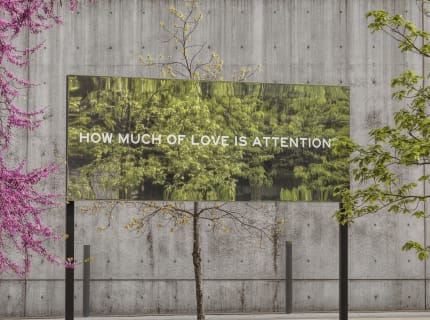I’ve gotten to know Wayfinding well. Every day I walk by some, if not all, of the twenty-four signs that compose Chloë Bass’s meditative, ever-unfolding, treasure hunt–like installation in Harlem’s St. Nicholas Park. (It has taken months for me to spot them all.) The project, commissioned by the Studio Museum in Harlem and curated by Legacy Russell, appeared last fall as part of the institution’s series of off-site community programming, which continues while its new building is under construction.
The Conceptual artist, who grew up in New York City, has placed most of her messages along a beautiful tree-lined path between West 133rd and West 137th Streets. It runs roughly parallel and almost adjacent to St. Nicholas Avenue, next to a well-shaded playground and the bottom of a hillside meadow where people sunbathe in warm weather and sled in the winter. At one edge, a staircase provides a scenic shortcut through the park from the West 135th Street subway station to the City College of New York campus, connecting the surrounding neighborhoods that have changed dramatically through fits and starts of development and gentrification in recent decades. Named for the term used by architects for the planning of spatial cues, Wayfinding takes physical navigation as a metaphor for philosophical wandering, mapping private ruminations onto public space.
Bass’s austere insertions range in scale from unobtrusive plaques, similar to those plant identifiers you’d find in a public garden, to small billboards, and are in conversation with the park’s usual signage, such as the designations for barbecue areas (or, as of this writing in April, the red notices that prohibit gatherings and spell out social-distancing guidelines). The three largest signs are mirrored. Their matte text can be hard to read, getting lost in the reflection of the apartment buildings across the avenue or obscured by the sun’s glare. HOW MUCH OF LOVE IS ATTENTION? asks one; HOW MUCH OF CARE IS PATIENCE? asks another. And the third commiserates with us during this sad time with the question HOW MUCH OF LIFE IS COPING? From certain angles, the big signs perform tricks, flipping the landscape upside down by refracting slices of bright or overcast sky onto the lawn.
The things we might think about while lying in the grass or when walking with headphones on, as I do daily in this park, suddenly appear grand and official when inscribed on these monumental sculptures—they become indisputably real and collective concerns. In contrast to the billboards’ sweeping prompts, Bass deploys more confessional—or confrontational—statements in smaller pieces you’re mostly likely to encounter alone on the path or when you’re gazing down, waiting for your dog to pee. A medium-size sign disarms with THERE ARE TIMES WHEN I HAVE AGREED WITH YOU ONLY IN ORDER TO STAY ALIVE. And one—only about the height of a flowering bulb, sticking out of the gravelly ground, black with white text—says, THE UNSETTLING SYMPATHY AND GRACE OF SOMEONE WHO HANDS YOU THE THING YOU NEED THE SECOND BEFORE YOU REMEMBER ITS NAME.
There’s an unsettling sympathy in the surprise placement and poetic economy of these sculptures in the park’s topography, and grace in the project’s site-specific considerations, which are outlined most explicitly in the audio guide. Here Bass elevates the form with an illuminating, collage-like essay that intersperses technical discussion of architectural wayfinding elements (it lists paths, markers, nodes, edges, and zones) with readings from Yelp reviews of the park. These accounts detail amenities as well as an incident of police harassment to highlight the ground’s historical significance and its social complexity, as a space presumably open to all but still fraught with inequality. The guide is available online, though it’s even better, I think, to call (888) 411-1250 and listen for a while in the sun.
Bass’s first-person musings are the audio piece’s glue—and the source of the project’s defining paradox. When you hear the cryptic or comforting messages in her voice, they are like thoughts shared in confidence, quietly on the phone. Emblazoned on scattered signs, they form strange landmarks leading to expansive introspection and—for me, literally—marking the path home.
...
Read the full article at artforum.com.

